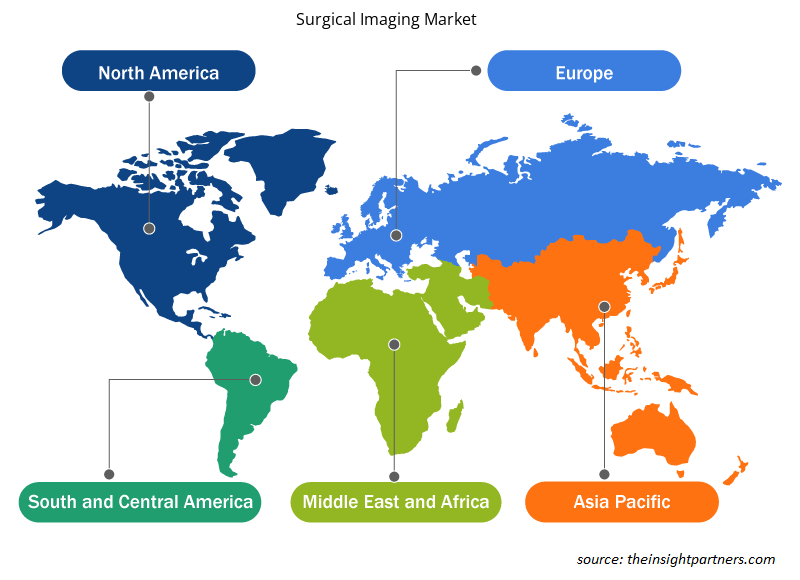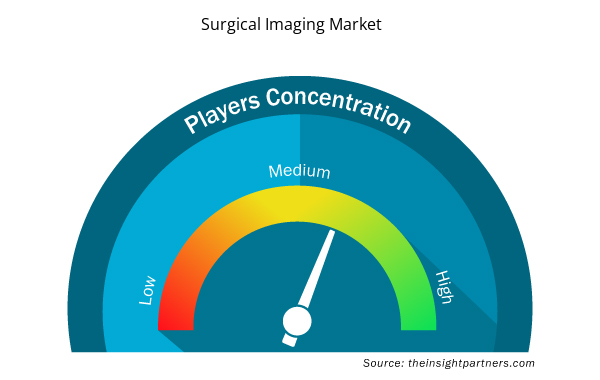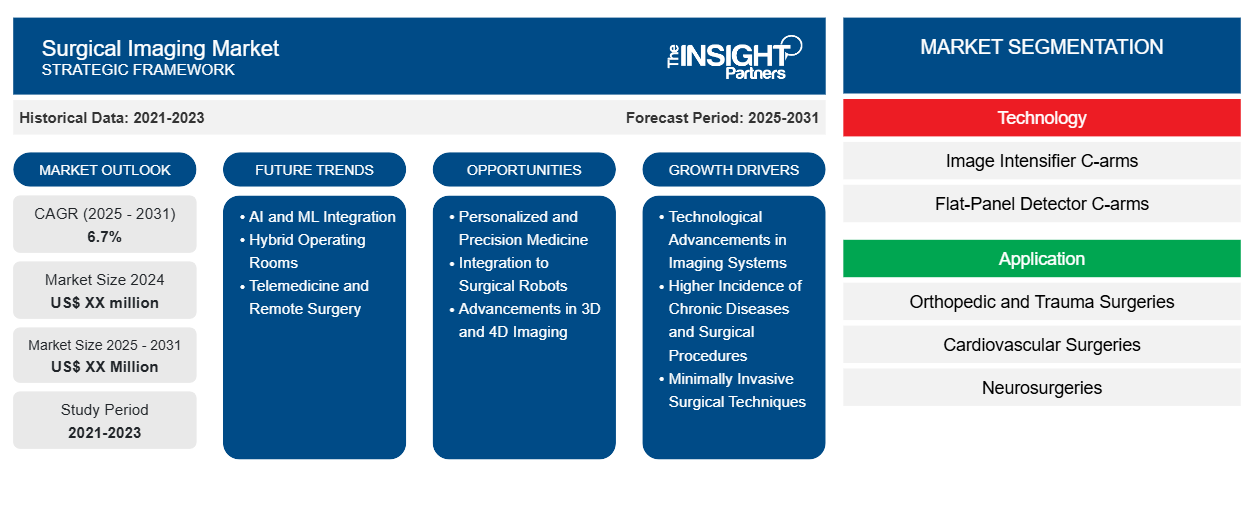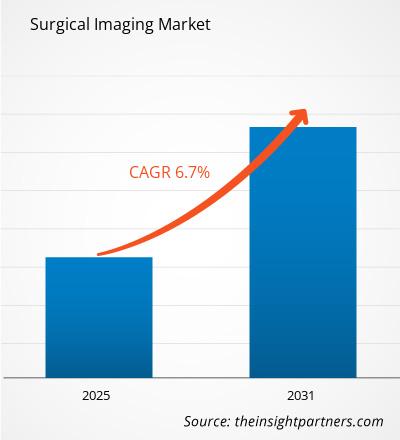Se espera que el mercado de imágenes quirúrgicas registre una CAGR del 6,7 % entre 2023 y 2031, con un tamaño de mercado que se expandirá de US$ XX millones en 2023 a US$ XX millones en 2031.
El informe está segmentado por tecnología (arcos en C intensificadores de imagen y arcos en C detectores de panel plano (FPD)). El informe presenta además un análisis basado en la aplicación (cirugías ortopédicas y de traumatología, cirugías cardiovasculares, neurocirugías, cirugías gastrointestinales y otras). El informe está segmentado por usuario final (hospitales, centros quirúrgicos y clínicas y otros). El análisis global se desglosa aún más a nivel regional y por países principales. El informe ofrece el valor en USD para el análisis y los segmentos anteriores.
Propósito del Informe
El informe Surgical Imaging Market de The Insight Partners tiene como objetivo describir el panorama actual y el crecimiento futuro, los principales factores impulsores, los desafíos y las oportunidades. Esto proporcionará información a diversas partes interesadas del negocio, como:
- Proveedores/fabricantes de tecnología: Para comprender la dinámica cambiante del mercado y conocer las oportunidades potenciales de crecimiento, lo que les permitirá tomar decisiones estratégicas informadas.
- Inversionistas: Realizar un análisis exhaustivo de tendencias sobre la tasa de crecimiento del mercado, las proyecciones financieras del mercado y las oportunidades que existen en toda la cadena de valor.
- Órganos reguladores: Regular las políticas y vigilar las actividades del mercado con el objetivo de minimizar los abusos, preservar la confianza de los inversores y defender la integridad y la estabilidad del mercado.
Segmentación del mercado de imágenes quirúrgicas
Tecnología
- Arcos en C intensificadores de imagen
- Arcos en C para detectores de panel plano
Solicitud
- Cirugías ortopédicas y traumatológicas
- Cirugías cardiovasculares
- Neurocirugías
- Cirugías gastrointestinales
Usuario final
- Hospitales
- Centros y clínicas de cirugía
Geografía
- América del norte
- Europa
- Asia-Pacífico
- América del Sur y Central
- Oriente Medio y África
Geografía
- América del norte
- Europa
- Asia-Pacífico
- América del Sur y Central
- Oriente Medio y África
Personalice este informe según sus necesidades
Obtendrá personalización en cualquier informe, sin cargo, incluidas partes de este informe o análisis a nivel de país, paquete de datos de Excel, así como también grandes ofertas y descuentos para empresas emergentes y universidades.
- Obtenga las principales tendencias clave del mercado de este informe.Esta muestra GRATUITA incluirá análisis de datos, desde tendencias del mercado hasta estimaciones y pronósticos.
Factores impulsores del crecimiento del mercado de imágenes quirúrgicas
- Technological Advancements in Imaging Systems: Continued development of advanced imaging technologies such as 3D and 4D imaging, HD visualization, and intraoperative imaging systems are significant growth impelling factors for the surgical imaging market. These technologies improve the accuracy and precision of surgeries with better patient outcomes and reduced complications. Intraoperative CT, MRI, and fluoroscopy systems provide real-time imaging so that surgical procedures can be performed and patients managed more optimally by the surgeons.
- Higher Incidence of Chronic Diseases and Surgical Procedures: As chronic diseases have increased throughout the world due to the rapidly growing populations-such as cardiovascular diseases, cancer, neurological disorders, and orthopedic problems-people are increasingly undergoing surgical procedures. These diseases /surgical conditions require more complex and/or precise surgical intervention; therefore, advanced imaging devices are important in enabling better diagnosis, treatment, and intra-operative monitoring. Also, aging is a factor; older people will generally be in need of surgery more than younger people.
- Minimally Invasive Surgical Techniques: Minimally invasive surgery (MIS), encompassing techniques such as laparoscopy and robotic-assisted surgery, is becoming more the standard in many areas of medical specialties. The techniques primarily rely on the use of surgical imaging, which enables real-time visualization of internal organs and tissues with minimal disruption to the body. Its benefits, including shorter recovery time, less pain, and lower risk of infection, advance the adoption of these techniques. Demand is, therefore, arising for imaging systems that can support such procedures.
Surgical Imaging Market Future Trends
- AI and ML Integration: AI and ML mathematical tools are changing the way imaging data is interpreted and applied to surgical needs. Such tools can find hidden patterns in images that are missed by human eyes and use them to make more accurate diagnosis and better decision-making during surgery. The more modern application of surgical navigation systems that also utilize AI helps increase the precision and accuracy of complex surgeries with better patient outcomes.
- Hybrid Operating Rooms: Hybrid operating rooms, integrating advanced imaging systems (like angiography and CT scans) with the surgical environment, are increasingly used today. These rooms enable surgeons to perform complex procedures like vascular and neurovascular surgeries with real-time imaging support. Hybrid operating rooms allow much more complex procedures in one setting, so that patients can benefit from better surgery and quicker recovery.
- Telemedicine and Remote Surgery: With telemedicine and remote surgery all over the place, especially since the COVID-19 situation, there is a great need to share high-quality real-time images between surgical teams that are at times located across vast distances. Thanks to high-speed internet and related high-definition imaging technologies, remote surgical guidance, where specialists are able to assist local surgeons in real time via video and imaging, is very possible. This trend has significant implications in rural and underserved areas, where patients less likely have direct access to adequately trained specialists.
Surgical Imaging Market Opportunities
- Personalized and Precision Medicine: Advances in genomics and molecular medicine are driving the demand for more individualized healthcare. Surgical imaging technologies are key enablers of precision medicine, as doctors can make better decisions based on anatomy and the particular features of disease in a patient. The imaging systems would have to be developed such that they could achieve a very highly detailed image of the specific patient- for the purpose of achieving a specific tailoring of the approach that would be possible for the surgeon in every case.
- Integration to Surgical Robots: The greatest potential for integrating surgical imaging systems probably lies in robotic surgery itself. Robotic platforms, like the da Vinci Surgical System, require real-time imaging for accurate navigation, thus the increased demand of robotic-assisted surgeries will open up doors to the opportunities of collaboration between imaging companies and robotics manufacturers in providing an integrated solution that improves both the accuracy of surgical procedures and workflow.
- Advancements in 3D and 4D Imaging: The emergence of 3D and 4D imaging technologies signifies new prospects in the surgical imaging market. These technologies enable capturing highly detailed, dynamic pictures of the human body for a surgeon to better understand the anatomy and pathology. The further development of 3D/4D imaging systems, especially in the area of tumor visualization, organ mapping, and real-time monitoring, will create huge growth opportunities for companies within the surgical imaging space.
Surgical Imaging Market Regional Insights
The regional trends and factors influencing the Surgical Imaging Market throughout the forecast period have been thoroughly explained by the analysts at Insight Partners. This section also discusses Surgical Imaging Market segments and geography across North America, Europe, Asia Pacific, Middle East and Africa, and South and Central America.

- Get the Regional Specific Data for Surgical Imaging Market
Surgical Imaging Market Report Scope
| Report Attribute | Details |
|---|---|
| Market size in 2023 | US$ XX million |
| Market Size by 2031 | US$ XX Million |
| Global CAGR (2023 - 2031) | 6.7% |
| Historical Data | 2021-2022 |
| Forecast period | 2024-2031 |
| Segments Covered | By Technology
|
| Regiones y países cubiertos | América del norte
|
| Líderes del mercado y perfiles de empresas clave |
|
Densidad de actores del mercado de imágenes quirúrgicas: comprensión de su impacto en la dinámica empresarial
El mercado de imágenes quirúrgicas está creciendo rápidamente, impulsado por la creciente demanda de los usuarios finales debido a factores como la evolución de las preferencias de los consumidores, los avances tecnológicos y una mayor conciencia de los beneficios del producto. A medida que aumenta la demanda, las empresas amplían sus ofertas, innovan para satisfacer las necesidades de los consumidores y aprovechan las tendencias emergentes, lo que impulsa aún más el crecimiento del mercado.
La densidad de actores del mercado se refiere a la distribución de las empresas o firmas que operan dentro de un mercado o industria en particular. Indica cuántos competidores (actores del mercado) están presentes en un espacio de mercado determinado en relación con su tamaño o valor total de mercado.
Las principales empresas que operan en el mercado de imágenes quirúrgicas son:
- Atención sanitaria Siemens
- Compañía: Hitachi Ltd.
- Atención sanitaria de GE
- Philips NV, la línea Koninklijke
- Corporación Canon Medical Systems
Descargo de responsabilidad : Las empresas enumeradas anteriormente no están clasificadas en ningún orden particular.

- Obtenga una descripción general de los principales actores clave del mercado de imágenes quirúrgicas
Puntos de venta clave
- Cobertura integral: el informe cubre de manera integral el análisis de productos, servicios, tipos y usuarios finales del mercado de imágenes quirúrgicas, proporcionando un panorama holístico.
- Análisis de expertos: el informe se compila sobre la base de un profundo conocimiento de expertos y analistas de la industria.
- Información actualizada: El informe asegura relevancia comercial debido a su cobertura de información reciente y tendencias de datos.
- Opciones de personalización: este informe se puede personalizar para satisfacer los requisitos específicos del cliente y adaptarse adecuadamente a las estrategias comerciales.
Por lo tanto, el informe de investigación sobre el mercado de imágenes quirúrgicas puede ayudar a abrir camino para descifrar y comprender el escenario de la industria y las perspectivas de crecimiento. Si bien puede haber algunas preocupaciones válidas, los beneficios generales de este informe tienden a superar las desventajas.
- Análisis histórico (2 años), año base, pronóstico (7 años) con CAGR
- Análisis PEST y FODA
- Tamaño del mercado Valor/volumen: global, regional, nacional
- Industria y panorama competitivo
- Conjunto de datos de Excel


- Carbon Fiber Market
- Excimer & Femtosecond Ophthalmic Lasers Market
- Hand Sanitizer Market
- Batter and Breader Premixes Market
- Virtual Production Market
- Airport Runway FOD Detection Systems Market
- Mice Model Market
- Occupational Health Market
- Sterilization Services Market
- Rare Neurological Disease Treatment Market

Report Coverage
Revenue forecast, Company Analysis, Industry landscape, Growth factors, and Trends

Segment Covered
This text is related
to segments covered.

Regional Scope
North America, Europe, Asia Pacific, Middle East & Africa, South & Central America

Country Scope
This text is related
to country scope.
Preguntas frecuentes
Image Intensifier C-arms segment, by technology, dominated the market in 2023.
Players operating in the market are Siemens Healthcare, Hitachi Ltd., GE Healthcare, Koninklijke Philips N.V., Canon Medical Systems Corporation, Hologic, Inc., Medtronic PLC, Shimadzu Corporation, Ziehm Imaging
North America region dominated the Surgical Imaging market in 2023.
Personalized and Precision Medicine Growth act as a opportunity for growth of the market in forecast period.
The Surgical Imaging Market is estimated to witness a CAGR of 6.7% from 2023 to 2031
The major factors driving the Surgical Imaging market are: 1. Technological Advancements in Imaging Systems, 2. Higher Incidence of Chronic Diseases and Surgical Procedures
Trends and growth analysis reports related to Life Sciences : READ MORE..
1. Siemens Healthcare
2. Hitachi Ltd.
3. GE Healthcare
4. Koninklijke Philips N.V.
5. Canon Medical Systems Corporation
6. Hologic, Inc.
7. Medtronic
8. PLC
9. Shimadzu Corporation
10. Ziehm Imaging
11. Orthoscan, Inc.
12. Eurocoloumbus Srl
13. Allengers Medical System Limited
14. General Electric Company
The Insight Partners performs research in 4 major stages: Data Collection & Secondary Research, Primary Research, Data Analysis and Data Triangulation & Final Review.
- Data Collection and Secondary Research:
As a market research and consulting firm operating from a decade, we have published and advised several client across the globe. First step for any study will start with an assessment of currently available data and insights from existing reports. Further, historical and current market information is collected from Investor Presentations, Annual Reports, SEC Filings, etc., and other information related to company’s performance and market positioning are gathered from Paid Databases (Factiva, Hoovers, and Reuters) and various other publications available in public domain.
Several associations trade associates, technical forums, institutes, societies and organization are accessed to gain technical as well as market related insights through their publications such as research papers, blogs and press releases related to the studies are referred to get cues about the market. Further, white papers, journals, magazines, and other news articles published in last 3 years are scrutinized and analyzed to understand the current market trends.
- Primary Research:
The primarily interview analysis comprise of data obtained from industry participants interview and answers to survey questions gathered by in-house primary team.
For primary research, interviews are conducted with industry experts/CEOs/Marketing Managers/VPs/Subject Matter Experts from both demand and supply side to get a 360-degree view of the market. The primary team conducts several interviews based on the complexity of the markets to understand the various market trends and dynamics which makes research more credible and precise.
A typical research interview fulfils the following functions:
- Provides first-hand information on the market size, market trends, growth trends, competitive landscape, and outlook
- Validates and strengthens in-house secondary research findings
- Develops the analysis team’s expertise and market understanding
Primary research involves email interactions and telephone interviews for each market, category, segment, and sub-segment across geographies. The participants who typically take part in such a process include, but are not limited to:
- Industry participants: VPs, business development managers, market intelligence managers and national sales managers
- Outside experts: Valuation experts, research analysts and key opinion leaders specializing in the electronics and semiconductor industry.
Below is the breakup of our primary respondents by company, designation, and region:

Once we receive the confirmation from primary research sources or primary respondents, we finalize the base year market estimation and forecast the data as per the macroeconomic and microeconomic factors assessed during data collection.
- Data Analysis:
Once data is validated through both secondary as well as primary respondents, we finalize the market estimations by hypothesis formulation and factor analysis at regional and country level.
- Macro-Economic Factor Analysis:
We analyse macroeconomic indicators such the gross domestic product (GDP), increase in the demand for goods and services across industries, technological advancement, regional economic growth, governmental policies, the influence of COVID-19, PEST analysis, and other aspects. This analysis aids in setting benchmarks for various nations/regions and approximating market splits. Additionally, the general trend of the aforementioned components aid in determining the market's development possibilities.
- Country Level Data:
Various factors that are especially aligned to the country are taken into account to determine the market size for a certain area and country, including the presence of vendors, such as headquarters and offices, the country's GDP, demand patterns, and industry growth. To comprehend the market dynamics for the nation, a number of growth variables, inhibitors, application areas, and current market trends are researched. The aforementioned elements aid in determining the country's overall market's growth potential.
- Company Profile:
The “Table of Contents” is formulated by listing and analyzing more than 25 - 30 companies operating in the market ecosystem across geographies. However, we profile only 10 companies as a standard practice in our syndicate reports. These 10 companies comprise leading, emerging, and regional players. Nonetheless, our analysis is not restricted to the 10 listed companies, we also analyze other companies present in the market to develop a holistic view and understand the prevailing trends. The “Company Profiles” section in the report covers key facts, business description, products & services, financial information, SWOT analysis, and key developments. The financial information presented is extracted from the annual reports and official documents of the publicly listed companies. Upon collecting the information for the sections of respective companies, we verify them via various primary sources and then compile the data in respective company profiles. The company level information helps us in deriving the base number as well as in forecasting the market size.
- Developing Base Number:
Aggregation of sales statistics (2020-2022) and macro-economic factor, and other secondary and primary research insights are utilized to arrive at base number and related market shares for 2022. The data gaps are identified in this step and relevant market data is analyzed, collected from paid primary interviews or databases. On finalizing the base year market size, forecasts are developed on the basis of macro-economic, industry and market growth factors and company level analysis.
- Data Triangulation and Final Review:
The market findings and base year market size calculations are validated from supply as well as demand side. Demand side validations are based on macro-economic factor analysis and benchmarks for respective regions and countries. In case of supply side validations, revenues of major companies are estimated (in case not available) based on industry benchmark, approximate number of employees, product portfolio, and primary interviews revenues are gathered. Further revenue from target product/service segment is assessed to avoid overshooting of market statistics. In case of heavy deviations between supply and demand side values, all thes steps are repeated to achieve synchronization.
We follow an iterative model, wherein we share our research findings with Subject Matter Experts (SME’s) and Key Opinion Leaders (KOLs) until consensus view of the market is not formulated – this model negates any drastic deviation in the opinions of experts. Only validated and universally acceptable research findings are quoted in our reports.
We have important check points that we use to validate our research findings – which we call – data triangulation, where we validate the information, we generate from secondary sources with primary interviews and then we re-validate with our internal data bases and Subject matter experts. This comprehensive model enables us to deliver high quality, reliable data in shortest possible time.


 Obtenga una muestra gratuita de este informe
Obtenga una muestra gratuita de este informe